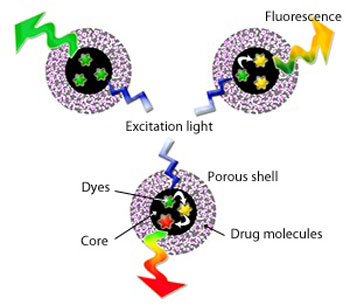| Aug 08, 2011 |
Nanomedicine: Multiplying the possibilities
|
|
(Nanowerk News) Single nanoparticles that integrate multiple functions, such as biosensing and drug delivery, are important for rapid, cost-effective medical diagnosis and treatment. A research team led by Jinlong Zhang and Lingzhi Wang from the East China University of Science and Technology in Shanghai has now developed a system to track drug transport and release in real-time using silica-based spherical nanoparticles that encase drug molecules and emit extremely intense fluorescence ("Superbright Multifluorescent Core-Shell Mesoporous Nanospheres as Trackable Transport Carrier for Drug").
|
|
Similar porous nanostructures have been combined previously with fluorescent molecules to synthesize drug delivery systems. However, past attempts have resulted in ill-defined and sometimes toxic drug carriers that degrade easily when exposed to light.
|
 |
| CAPTION
|
|
By encapsulating three types of organic dyes in the nanoparticle core, Zhang's team obtained biocompatible, photostable carriers that fluoresce in different colors when exposed to the same wavelength of light (see image). Unlike previous systems, these 'multifluorescent' spheres are detectable in the body, allowing the different transport routes for different drug molecules to be tracked in real time.
|
|
Zhang explains that the growing diversification and complication of diseases makes multiple bioassay and drug-delivery monitoring essential. "Simultaneously fluorescence-trackable drug carriers will ensure that drugs are precisely located in different target organs in complex in vivo environments."
|
|
The researchers prepared their nanoparticles by attaching dyes to silicon-based coupling agents and reacting the resulting conjugates with a silica precursor and ammonia. This process trapped the dyes and at the same time prevented any leakage from the core. The porous shell to host the drug molecules was then formed by adding more of the silica precursor in the presence of surfactants.
|
|
Investigations of the nanoparticle performance in loading and releasing therapeutic agents like ibuprofen showed that most of the adsorbed drug steadily exited the spheres within two days in a simulated body fluid while the optical properties of the carriers remained unchanged, evidence that the dyes did not leak from the core. Further studies in human cervical cancer cells showed that the nanoparticles effectively penetrated into the cell cytoplasm, where they generated strong fluorescence signals.
|
|
The researchers are now planning to incorporate other functional groups into these nanoparticles for the synchronized identification of intracellular events, bioimaging and target drug delivery.
|

